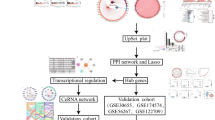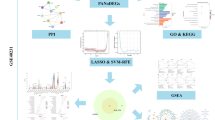Abstract
Methylglyoxal (MG) is a highly toxic compound that contributes to the formation of advanced glycation end products (AGEs). MG is detected at high concentration in plasma of diabetic patients and is involved in the pathogenesis of several diabetic macro- and microvascular complications, such as atherosclerosis, retinopathy, nephropathy and hypertension. MicroRNAs (miRNAs) play a critical role in the negative regulation of genes in many biologic processes. They are also known to post-transcriptionally regulate gene expression involved in cellular responses to toxicants. In this study, we investigated whether miRNAs play a role in the regulation of gene expressions in human umbilical vein endothelial cells (HUVECs) after the treatment with MG. We performed pair-wise correlation analysis, acquired altered expression levels of 274 miRNAs and 686 mRNA, and observed their anti-correlations. Genes associated with diabetic vascular disease were sorted from miRNA-correlated genes, and Gene Ontology (GO) enrichment analysis on the differential expression of selected genes was carried out. Our results revealed the relationship between miRNAs and mRNA in MG-exposed endothelial cells using the expression profiling.
Similar content being viewed by others
References
Brandt, R.B. & Siegel, S.A. Methylglyoxal production in human blood. Ciba Found. Symp. 67, 211–223 (1978).
Westwood, M.E., McLellan, A.C. & Thornalley, P.J. Receptor-mediated endocytic uptake of methylglyoxal-modified serum albumin. Competition with advanced glycation end product-modified serum albumin at the advanced glycation end product receptor. J. Biol. Chem. 269, 32293–32298 (1994).
Thornalley, P.J. Pharmacology of methylglyoxal: formation, modification of proteins and nucleic acids, and enzymatic detoxification-a role in pathogenesis and antiproliferative chemotherapy. Gen. Pharmacol. 27, 565–573 (1996).
Vander Jagt, D.L. Methylglyoxal, diabetes mellitus and diabetic complications. Drug Metab. Drug Interact. 23, 93–124 (2008).
Sejersen, H. & Rattan, S.I.S. Dicarbonyl-induced accelerated aging in vitro in human skin fibroblasts. Biogerontology 10, 203–211 (2009).
Choudhary, D., Chandra, D. & Kale, R.K. Influence of methylglyoxal on antioxidant enzymes and oxidative damage. Toxicol. Lett. 93, 141–152 (1997).
Lee, S.E. et al. Methylglyoxal-mediated alteration of gene expression in human endothelial cells. BioChip J. 5, 220–228 (2011).
Wang, H., Liu, J. & Wu, L. Methylglyoxal-induced mitochondrial dysfunction in vascular smooth muscle cells. Biochem. Pharmacol. 77, 1709–1716 (2009).
Cantero, A.V. et al. Methylglyoxal induces advanced glycation end product (AGEs) formation and dysfunction of PDGF receptor-beta: implications for diabetic atherosclerosis. FASEB J. 21, 3096–3106 (2007).
Jeong, S.I. et al. Effect of alpha,beta-unsaturated aldehydes on endothelial cell growth in bacterial cellulose for vascular tissue engineering. Mol. Cell. Toxicol. 8, 119–126 (2012).
Park, Y.S. et al. Acrolein induces cyclooxygenase-2 and prostaglandin production in human umbilical vein endothelial cells-Roles of p38 MAP kinase. Arterioscler. Thromb. Vasc. Biol. 27, 1319–1325 (2007).
Yang, H. et al. An integrated analysis of microRNA and mRNA expression in salvianolic acid B-treated human umbilical vein endothelial cells. Mol. Cell. Toxicol. 9, 1–7 (2013).
Asgeirsdottir, S.A. et al. MicroRNA-126 contributes to renal microvascular heterogeneity of VCAM-1 protein expression in acute inflammation. Am. J. Physiol. Renal. Physiol. 302, 1630–1639 (2012).
Lema, C. & Cunningham, M.J. MicroRNAs and their implications in toxicological research. Toxicol. Lett. 198, 100–105 (2010).
Paul, S. et al. Impact of miRNA deregulation on mRNA expression profiles in response to environmental toxicant, nonylphenol. Mol. Cell. Toxicol. 7, 259–269 (2011).
Sun, X. et al. MicroRNA-181b regulates NF-kappaB-mediated vascular inflammation. J. Clin. Invest. 122, 1973–1990 (2012).
Caruso, P. et al. A Role for miR-145 in Pulmonary Arterial Hypertension. Circ. Res. 111, 290–300 (2012).
Fish, J.E. A primer on the role of MicroRNAs in endothelial biology and vascular disease. Semin. Nephrol. 32, 167–175 (2012).
Kim, J.H. Cardiovascular diseases and panax ginseng: a review on molecular mechanisms and medical applications. J. Ginseng Res. 36, 16–26 (2012).
Calles-Escandon, J. & Cipolla, M. Diabetes and endothelial dysfunction: a clinical perspective. Endocr. Rev. 22, 36–52 (2001).
Phillips, S.A., Mirrlees, D. & Thornalley, P.J. Modification of the glyoxalase system in streptozotocin-induced diabetic rats. Effect of the aldose reductase inhibitor Statil. Biochem. Pharmacol. 46, 805–811 (1993).
Han, Y. et al. Plasma methylglyoxal and glyoxal are elevated and related to early membrane alteration in young, complication-free patients with Type 1 diabetes. Mol. Cell. Biochem. 305, 123–131 (2007).
Ogawa, S. et al. Methylglyoxal is a predictor in type 2 diabetic patients of intima-media thickening and elevation of blood pressure. Hypertension 56, 471–476 (2010).
Forbes, J.M. et al. Advanced glycation end product interventions reduce diabetes-accelerated atherosclerosis. Diabetes 53, 1813–1823 (2004).
Vasdev, S. & Stuckless, J. Role of methylglyoxal in essential hypertension. Int. J. Angiol. 19, e58–65 (2010).
Zou, C., Wang, S., Huang, F. & Zhang, Y.A. Advanced glycation end products and ultrastructural changes in corneas of long-term streptozotocin-induced diabetic monkeys. Cornea 31, 1455–1459 (2012).
Srikanth, V. et al. Methylglyoxal, cognitive function and cerebral atrophy in older people. J. Gerontol. A. Biol. Sci. Med. Sci. 68, 68–73 (2012).
Lee, S.E. et al. MicroRNA and gene expression analysis of melatonin-exposed human breast cancer cell lines indicating involvement of the anticancer effect. J. Pineal. Res. 51, 345–352 (2011).
Mirnics, K. & Pevsner, J. Progress in the use of microarray technology to study the neurobiology of disease. Nature Neurosci. 7, 434–439 (2004).
Fekete, V. et al. Effect of type 2 diabetes on the gene expression pattern of rat hearts: a DNA microarray study. Cardiovasc. Res. 87, S116–S116 (2010).
Lee, S.E. et al. Differentially-expressed genes related to atherosclerosis in acrolein-stimulated human umbilical vein endothelial cells. BioChip J. 4, 264–271 (2010).
Ziyadeh, F.N. The extracellular matrix in diabetic nephropathy. Am J. Kidney Dis. 22, 736–744 (1993).
Ho, C. et al. Methylglyoxal-induced Fibronectin gene expression through Ras-mediated NADPH oxidase activation in renal mesangial cells. Nephrology 12, 348–356 (2007).
Golej, J., Hoeger, H., Radner, W., Unfried, G. & Lubec, G. Oral administration of methylglyoxal leads to kidney collagen accumulation in the mouse. Life Sci. 63, 801–807 (1998).
Staimer, N., Nguyen, T.B., Nizkorodov, S.A. & Delfino, R.J. Glutathione peroxidase inhibitory assay for electrophilic pollutants in diesel exhaust and tobacco smoke. Anal. Bioanal. Chem. 403, 431–441 (2012).
Park, Y.S. et al. Identification of the binding site of methylglyoxal on glutathione peroxidase: methylglyoxal inhibits glutathione peroxidase activity via binding to glutathione binding sites Arg 184 and 185. Free Radic. Res. 37, 205–211 (2003).
Yang, H. et al. Up-regulation of Heme Oxygenase-1 by Korean Red Ginseng Water Extract as a Cytoprotective Effect in Human Endothelial Cells. J. Ginseng Res. 35, 352–359 (2011).
Yang, H. et al. Expression profile analysis of human umbilical vein endothelial cells treated with salvianolic acid B from Salvia miltiorrhiza. BioChip J. 5, 47–55 (2011).
Lee, S.E. et al. Induction of Heme Oxygenase-1 Inhibits Cell Death in Crotonaldehyde-Stimulated HepG2 Cells via the PKC-delta-p38-Nrf2 Pathway. PLoS One 7, e41676 (2012).
Lee, S.E. et al. Genome-wide profiling in melatonin-exposed human breast cancer cell lines identifies differentially methylated genes involved in the anticancer effect of melatonin. J. Pineal. Res. 54, 80–88 (2013).
Author information
Authors and Affiliations
Corresponding author
Rights and permissions
About this article
Cite this article
Yang, H., Kim, GD., Park, H.R. et al. Comparative mRNA and microRNA expression profiling of methylglyoxal-exposed human endothelial cells. BioChip J 7, 143–150 (2013). https://doi.org/10.1007/s13206-013-7207-7
Received:
Accepted:
Published:
Issue Date:
DOI: https://doi.org/10.1007/s13206-013-7207-7




